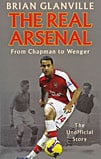 From Chapman to Wenger – The Unofficial Story
From Chapman to Wenger – The Unofficial Story
by Brian Glanville
JR Books, £18.99
Reviewed by Cameron Carter
From WSC 277 March 2010
Many histories have been written of Arsenal, but there are few that have the same personal touch as this one. At 19, Brian Glanville persuaded Cliff Bastin that he should ghost the winger’s memoirs and he has continued to write honestly and incisively about the game ever since.
Glanville’s relationship with the club is that of a habitually disappointed life coach. Cruelly, for a man who likes his football played with invention and style, he has been forced to endure whole eras in which his team have fielded dour, conservative midfields, a policy of direct football – stand up, Don Howe – or just plain poor sides. Intermittently he has been driven to wage one-man campaigns to appeal to managers to use their creative playmaker – Paul Davis and Anders Limpar are two cases in point – through his newspaper column.
In fact, Glanville’s own analyses of Arsenal’s strengths and failings through the ages, taken from his articles in the Times and the People, make up a large part of the source material here. What might appear self-indulgent is merely good sense – what better material than 60 years of first-hand accounts from a chap who has met most of the protagonists? Glanville is an Arsenal fan with the credentials of having watched legendary figures such as Bastin, Jimmy Logie and Ted Drake from the terraces and every subsequent Arsenal player from the press box. He is, furthermore, the ultimate reliable narrator, whether outlining Arsène Wenger’s disciplinary flaws or calling the Robert Pires dive against Portsmouth that secured a draw in the unbeaten season, there is no glossing over the club’s failings, big or small.
Glanville also records his own more unsatisfactory encounters with Arsenal people – a wounded and defensive Billy Wright in a BBC studio or a sarcastic Eddie Hapgood in a phone interview. At least on the flip side he will always have the memory of Paul Davis inviting himself round for tea to talk through his frustration at being left out of the team.
No player, however small their part in the club’s story, is dropped into the text without at least an accompanying phrase of identification. Sometimes Glanville is able to trace a line to the individual’s post-playing days – encountering KP O’Flanagan as a medical officer for the Irish team at the Tokyo Olympics, Alf Kirchen as a Norfolk farmer and, less happily, Jimmy Logie selling newspapers in Piccadilly. Glanville’s readiness to get down everything he knows occasionally suggests someone recounting a tale about an old friend, stopping off en route to recall who the friend married, how many children they had and which of the children went into the RAF. This would be an irritant in less skilled hands but instead draws the reader deeper into the Arsenal world, until, by the end of the book, you feel something like a friend of the family (which is still not enough to make you a Silver Member I’m afraid). Speaking of families and Glanville’s attention to minor detail, the relatives of Horace Cumner will be pleased to find their ancestor given a mention as the scorer of the only Arsenal goal in a 6-1 Cup thrashing in 1946.
Keeping to the review etiquette of pointing out stray errors in the text, Gordon McQueen scored with a stuck-out foot in the 1979 FA Cup final, not with his head as reported here; but this feels even more churlish than usual, such is the sheer weight of information within these pages. Glanville manages the difficult feat of combining the subjectivity of a fan – the memory of Pascal Cygan’s bullet header own goal in the European Cup still effects a marked physiological reaction – with the objectivity of a newspaper man steeped in the history of the world game. As you might expect, this is a highly literate, fair and accurate appraisal of Arsenal football club, from a writer whose only weakness is for describing current players as “clever little inside-forwards”.